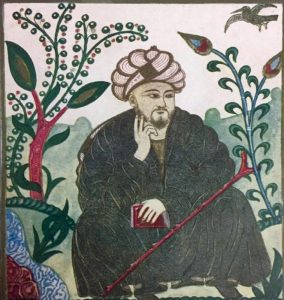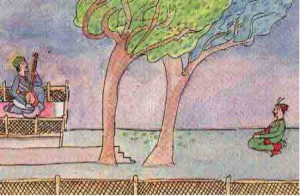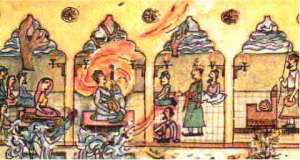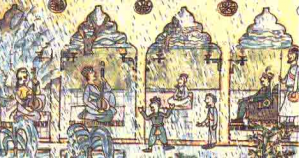Tales of the Effects
of Ragas in Ancient India
These are three stories from old texts that I discovered in my research in 1967 – Don Robertson
The Old Musician Who Lived in a Cave
High in the mountains of Northern India, there lived an old musician who lived alone in a cave. Stories about the old man and the great miracles that he could produce with his music had circulated all over India, and these stories reached the ears of one of the younger musicians who considered himself to be one of the very greatest musicians alive. This young musician set out to find the old man. After many days of traveling, he reached the old man’s cave, and there he saw the old man playing his vina (an Indian stringed instrument). The old man played so perfectly and so beautifully, that he had materialized seven little nymphs before him, and the nymphs danced to the music. Each nymph had been materialized by one of the seven notes of the raga (scales and melodic system in Indian classical music) that the old man was playing.
The young man was very impressed; however, he thought that he himself should be able to do the same thing, as he was one of the greatest musicians in India. He went forth and greeted the old man and the old man put down his instrument. The nymphs continued to appear before the two men. The younger musician asked the old man if he might play a little upon the old man’s vina, and the old man consented. The younger musician began to play the same raga that the older musician had been playing, but after only a few seconds, he struck one of the notes of the raga incorrectly, and one of the nymphs vanished into thin air. The young man, stunned, quickly put down the instrument. The old man picked it back up, then clearly plucked the correct note. The missing nymph reappeared. The young musician was so embarrassed, he bowed his head in shame and left the company of the old man to return to his home. He never felt the pride of his own greatness again.
The Story of Al-Farabi’s Visit to India
Al-Farabi (870-950 A.D.) was the great philosopher and musician from Turkestan who invented the musical instrument called the Quanun. He was known to travel to many parts of the world, and because he was very famous, he always assumed a disguise that he not be recognized. One day, when he was in India, he appeared in the throne room of the court of the great King Suffudeen, one of the most knowledgeable men in India, dressed as a private in the King’s own army. The king was very surprised to see a private standing in his royal room and demanded the private to tell him what he was doing there.

“Where do you belong, private,” he demanded.
“Why, I belong there on the throne, where you now sit!” the private exclaimed, walking up to the throne and sitting on the edge. He then began pushing his weight against the king, sliding him aside until each occupied half the throne.
The king was very angry and turned to one of his guards and began speaking a very obscure tongue so that others could not understand him. He told the guard “This man must either be a fanatic, or else he is someone very amazing. I will ask him some questions and see which case it may be.”
The king turned to Al-Farabi to ask him a question; However, before he could open his mouth, Al-Farabi spoke to him in the same obscure language and said, “But king, why would you bother?”
At this point, the king and Al-Farabi launched into a lengthy philosophical debate that lasted several hours. Point by point, the king’s arguments were defeated, and as the wisest men in India were brought in to contribute to the debate, one by one they were defeated. Finally, the king graciously accepted his defeat and told Al-Farabi that he would willingly give him whatever he wanted. Al-Farabi said that he wanted nothing. So, the King ordered his fine court musicians, who were the best in the land, to play for the, now honored, guest.
When the musicians began playing, Al-Farabi stopped them and corrected their intonation and their interpretation of the ragas. Then he demanded that the musicians replay the music correctly. This kept on occurring, every time the musicians tried to play and after a while, the king dismissed the musicians. He then told Al-Farabi that since he had treated his musicians in such a manner, he must prove his own musical ability.
Al-Farabi pulled three small reeds from his pocket and began playing a high, happy tune that, when played over and over, made everyone in the courtroom, including the king, break out in laughter. Finally, everyone in the court, including the king, were rolling on their sides in fits of uncontrollable laughter. Suddenly, Al-Farabi stopped the tune, and began playing another, a slow mournful one that put everyone to sleep, and when every person in the room, except Al-Farabi, was fast asleep in their chairs or on the floor, Al-Farabi quietly slipped out of the throne room, never to be seen there again.
Tansen - The Magical Musician
by Ashok Davar (National Book Trust, India)
At most exactly in the center of India is a town called Gwalior. In this town is the tomb of Tansen, one of the greatest musicians [who] ever lived. Next to his beautifully carved stone tomb stands a little tamarind tree. It is believed that by eating a leaf of this tree and touching the tomb, a singer can improve his voice.
If this sounds like magic, the story of Tansen is equally magical. Even today, many famous musicians follow the style of music created by Tansen known as the Gwalior Gharana.
About four hundred years ago, in a village near Gwalior, lived a wealthy poet, Mukand Mishra, and his wife.

Their only sorrow was that they had no children. On the suggestion of a friend, Mishra went to Gwalior to seek the blessings of the famous saint and musician, Mohammad Ghaus.
He tied a holy thread on Mishra’s arm, saying, “May God bless you with a son.” And so, it came to pass. A child was born and named Tansen. As Tansen grew up his father engaged teachers to teach him to read and write. Tansen, however, was more interested in going to the nearby forest with his friends, where he would imitate bird and animal sounds.
Once a group of singers were passing through the forest. Tansen hid himself in some bushes and roared like a tiger. So, life-like was the sound that the singers became frightened. When the boy showed himself, the leader of the group praised his tiger-like roar. Encouraged, Tansen made more animal and bird sounds.
The leader was greatly impressed by Tansen’s performance. He was none other than the famous music teacher, Haridas.
Haridas offered to take Tansen as his disciple. “He has great musical talent,” said Haridas to Tansen’s father. Most reluctantly, Tansen’s mother agreed to let her only child go away to Brindaban to study under Haridas. For almost ten years Tansen studied music from Haridas. Starting with the basic musical notes Sa Re GA Ma Pa Dha Ni Sa [Do Re Mi Fa So La Ti Do], he learned the basics of singing and playing the tanpura [Indian string instrument that provides a drone to accompany singers and instrumentalists]. He learnt about the different ragas of Indian music and how each raga creates a different mood. A raga can make you so happy that you want to dance, or it can make you so sad that it brings tears to your eyes.
Then one day there was a message from home that his father was very ill. When Tansen arrived home he found his father on his deathbed.
“I am happy that you have become a musician. Go and see Mohammad Ghaus,” were his father’s last words to him. Tansen remained at home to look after his mother, but within a year she, too, died.
Now Tansen was free to keep his promise to his father to go to Mohammad Ghaus and be trained by him. But, in keeping with Indian tradition, he went to seek permission to learn under a new guru from his first guru, Haridas.
“You must obey your father’s wishes, but you will always be welcome here. You are like a son to me,” said Haridas. And he gave him his blessings.
Tansen studied under Mohammad Ghaus for three years, developing his musical talent.
During that time Mohammad Ghaus introduced Tansen to the ruler of Gwalior. They became good friends and Tansen would often visit the ruler’s palace, where he would listen to other musicians.
During his visits to the palace, Tansen met Husani, one of the women who attended on the ruler. Like her name “the beautiful one,” Husani was truly beautiful. Tansen fell in love with her and married her. A few years later Mohammad Ghaus died, leaving his property and money to Tansen. Tansen settled in Mohammad Ghaus’s house and his family [was] raised there.
One day a messenger arrived from the court of Rewa, near Gwalior. The messenger opened the scroll and read: “King Ramchandra of Rewa would like you to be a musician at his court.”
This was a great honor and the first step in Tansen’s rise to fame.
King Ramchandra admired Tansen’s singing and lavished many expensive gifts on him. Once he gave him a thousand gold coins.
Then one day the emperor, Akbar, went on a visit to Rewa. King Ramchandra arranged for Tansen to entertain his royal guest.
The emperor was greatly impressed by Tansen’s music and, soon after his return, sent a message to Ramchandra requesting him to send Tansen to his court.
King Ramchandra did not want to part with Tansen, but he could not afford to displease the powerful Akbar. After all, Akbar was the emperor of India, and Ramchandra was only the king of a small state in Akbar’s empire.
So, reluctantly, King Ramchandra sent Tansen as a royal gift from one court to another escorted by his own men.
Tansen received a royal welcome in the capital city of Agra. Akbar was so impressed by Tansen’s music that he bestowed on him the highest honor of the land. Tansen was included among his navratna, nine jewels – the nine most outstanding talents of the royal court.
Besides performing in the court, Tansen would often sing alone for the emperor. At night he sang ragas that would soothe and help Akbar fall asleep, and in the morning Tansen sang special ragas that would gently awaken the emperor.
There are many stories told about the power of Tansen’s music. It is said that when Tansen sang, birds and animals would gather to hear him.
Once, during a hunting expedition, Emperor Akbar spotted a white elephant [that] he wanted for himself. The elephant was captured and brought to the palace. The elephant, however, was fierce and wild and would not be tamed.
When Tansen heard of this, he went to the elephant [that] was chained and struggling with the trainers.
He began to play the tanpura and sing. Gradually the elephant became calm, and soon the emperor was able to mount and ride it. Emperor Akbar bestowed honors and gifts on Tansen. Tansen was given a house very close to the royal palace.
One evening, Emperor Akbar decided to visit Tansen. When the emperor arrived, Tansen was singing and playing the tanpura. The emperor sat quietly in the verandah and listened to him.
So pleased was the emperor with Tansen’s music that after the performance he took off his diamond necklace and presented it to Tansen. Some courtiers became very jealous of the emperor’s high regard for Tansen. They began plotting Tansen’s downfall. They stole the diamond necklace given by the emperor and told him that Tansen had sold it for a large sum of money.
When summoned to the royal court and asked to produce the necklace, Tansen was unable to do so.
The emperor flew into a rage. “You will be banished from the court till you can present yourself wearing the necklace,” roared the emperor.
Tansen was in disgrace. He had no one to turn to. At last, he thought of King Ramchandra and set off for Rewa.
Ramchandra welcomed his former court musician. After hearing the whole story, the king said, “Don’t worry. Just sing for me.”
Tansen sang two beautiful ragas for the king.
“Your singing is now superb. You have brought me great joy,” said Ramchandra. And as a token of appreciation, he presented his jeweled sandals to Tansen.
Tansen rushed back to Agra and placed the jeweled sandals in front of the emperor. “Sire, please take the diamonds from these and forgive me.”
The jeweled sandals were worth much more than the necklace. The emperor immediately realized that he had misjudged Tansen and said, “Your music is much more valuable than diamonds to me. I should never have doubted you. You may return to the court as my royal musician.”
Tansen’s fame spread far and wide. People said Tansen was the greatest singer to have been born in a thousand years. Tansen’s enemies once more grew jealous and began to plot his downfall. They suggested to the emperor that he command Tansen to sing Raga Deepak for him.
Raga Deepak was one of the most difficult ragas to sing. Besides, so much heat would be caused by a perfect rendering of this raga that not only would lamps alight, but the singer’s body too would burn to ashes [deepak was the fire raga].
When Akbar asked Tansen to sing Raga Deepak, Tansen pleaded: “Sire, Raga Deepak can set the singer himself on fire. But the emperor would not listen. “If you are the greatest singer in the land, you must accept this challenge,” insisted Emperor Akbar.
Tansen knew that singing raga deepak was dangerous, but he also knew that if Raga Megh, which brings the rain, could be sung at the same time, he would be saved from the fury of fire [Megh is a water raga, associated with rain and the monsoons].
“But how can I sing both ragas at the same time,” Tansen thought worriedly to himself, as he roamed in the garden of his house. Suddenly he had an idea. Maybe Rupa, a devoted disciple of Haridas, could sing with him.
With the permission of Haridas, Rupa agreed to sing. Rupa was already a very good musician. Tansen used the fifteen days preparation time, granted by Akbar, to train her. At the end of the two weeks, Rupa had perfected the singing of Raga Megh.
On the day of the performance, the court was packed with courtiers and royal guests. People had come from far and near to hear Tansen sing the most difficult of all ragas, Raga Deepak.
Unlit lamps were placed on the walls.
Tansen was waiting with his tanpura in hand and, as soon as the emperor entered and sat on the throne, the great musician began the alap – the first portion of a raga.
As Tansen sang on, the surrounding air got warmer and warmer.
The audience started perspiring. Leaves and flowers in the garden dried and fell to the ground. Water in the fountains began to boil. Birds flew away to escape. The lamps lit up and flames appeared in the air. People fled from the court in terror. As the emperor got up and stood, listening with awe, a rose that he often held in his hand drooped and died.
Now Tansen’s body was hot and feverish but absorbed in Raga Deepak he continued to sing vigorously.
Seeing Tansen in this state, Rupa became anxious and was unable to start singing. Then slowly, although waveringly at first, she began singing Raga Megh.
As her voice grew stronger and soared, the sky became dark with clouds. Soon rain came pouring down. Many among the audience rushed out to be cooled by the rain. Soon everything returned to normal. People showered praises on Tansen’s genius. Though the emperor was very pleased, he was shocked that he had almost lost his greatest musician to the fire of the singer’s own music.
Tansen’s fame now spread like the flames of Raga Deepak.
For the singer himself, however, the internal fire lit by Raga Deepak did not cool easily. Tansen fell ill and it was two months before he could return to the court.
Tansen sang and taught in Emperor Akbar’s court for many years. He was not only a musician, but also a poet. He wrote the words for his music and composed many new ragas.
When Tansen died, Emperor Akbar was at his bedside. The emperor was filled with great sorrow. He knew that India had lost her greatest musician and singer. But Tansen’s music has lived on and been passed on from guru to disciple.
And every year in Gwalior, near Tansen’s tomb, a music festival is held. Musicians come here from all over India to perform and pay homage to Tansen.


